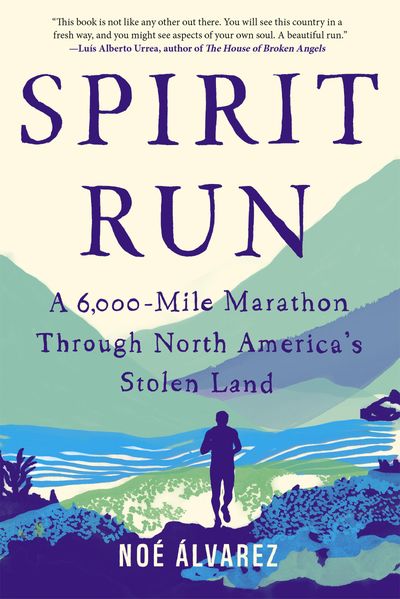Noé Alvarez’s ‘Spirit Run’: Running thousands of miles to connect with his heritage

As a teenager, Noé Alvarez worked the day shift with his mother at a massive fruit production and distribution center that confined “migrant labor inside, as prisons might,” he writes in his new memoir, “Spirit Run: A 6,000-Mile Marathon Through North America’s Stolen Land.”
Alvarez grew up in the agricultural community of Yakima the son of two farmworkers who had emigrated from Mexico and ended up working in orchards and fruit-packing plants. “There’s nothing uplifting about this kind of work,” Alvarez writes. His father laid out the choices available to him: “It’s either college or the fields, Noé.”
In “Spirit Run,” Alvarez tells the story of how running the length of North America brought him closer to the land, his indigenous and immigrant ancestors and his own identity.
Before setting off on his long-distance run, Alvarez chose college over working in the fields. When he was accepted by Whitman College, he was overcome with joy but also reminded of “all the times I was told to set my goals lower.” His academic achievements earned him a scholarship, which eased the financial burden but not the cultural transition.
The college dining hall offered food that was unfamiliar to him. “Words like vegan, toxins, paleo, organic, grass-fed and soy-based don’t help clarify for me what the foods actually are,” he recalls. The tortillas he’d grown up eating “are something else in college. They’re burrito wraps and not finger food. I can’t eat normally here,” he writes. To overcome his self-consciousness, he sat in his room, “stomach growling,” and waited until 15 minutes before closing time to go to the dining hall and eat alone.
Alvarez felt adrift until spring 2004, when he came across a brochure announcing a marathon of indigenous runners: Their route would take them from Alaska to the Panama Canal. Held every four years, the Peace and Dignity Journeys were inspired by a 1966 march from Delano, California, to Sacramento to protest the labor conditions of Latino and Filipino grape workers. On the journey, the runners passed through hundreds of indigenous communities where they took part in spiritual practices and traditions.
Alvarez’s paternal grandfather is of Puripecha indigenous descent, and Alvarez felt a pull to explore and understand his ancestry.
So three days after his 19th birthday, he dropped out of college and bought a one-way plane ticket to Canada to join the PDJ run using a $500 check that the president of Whitman College gave him to help fund his journey.
On the run, he had to fight for the respect and acceptance of his companions. Among them were 29-year-old Cheeto, who immigrated to Oakland, California, from Mexico as a toddler; Zyanya Lonewolf of the Gitxsan and Dakelh nations, who quit her job flipping burgers at a McDonald’s in Smithers, Canada, to join the run; and Tlaloc, who has a “ripped physique like that of Rambo – a name he insists people call him.” The run’s leader, Pacquiao, is of Yaqui, Tohono O’odham and Opata heritage, and his “soul is branded” by the copper mine strike that he witnessed as a 10-year-old in his hometown of Ajo, Arizona, in 1983.
These runners were a blend of cultures, and sometimes they clashed. They confronted the petty conflicts that arise in any group forced to live in close quarters, as well as deeper disagreements over how to engage in the ceremonial rituals in the local communities they visited.
The PDJ isn’t a wilderness adventure. Runners traverse mountains and forests, but also busy streets in urban communities like Oakland, East Los Angeles and Mexico City.
The run changed the way Alvarez viewed his relationship to the land and to running. Growing up, he writes, “The motion of running to me meant a defensive act, one that arose from the fear and desperation of a vulnerable people who were running as a means of survival.” But on the PDJ, running became an act of “ ‘belonging to the land’ – a value deeply held among Native communities.”
In Nogales, Arizona, he came face to face with the U.S.-Mexico border, which throughout his life had split him in two, “Between who I am in the U.S. and the people my parents were in Mexico,” he writes. “For longer than I can remember, I was ashamed of who I was. I was ashamed for having no real sense of place or home, and it has taken this run across North America to learn that home is everywhere in movement.” Alvarez believed he had “confused the negative Latino stereotypes for my own story … and internalized them for truth.”
Running helps “vanquish these feelings,” he writes. “It reminds me that I have been telling myself the wrong story – that I don’t really belong, that we Latinos are an inferior people. … As long as I keep repeating these stories to myself, I will never escape their realities. In order to become someone else – achieve the full potential of my being, I have to engage in new imaginative acts.” Running is one of these acts.
Alvarez has established himself as an important voice for second-generation Americans who too often are made to feel as if they are outsiders in their Native country. His story represents a powerful reclaiming of his right to belong.